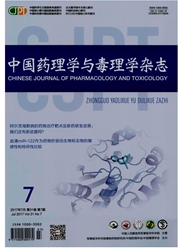

 中文摘要:
中文摘要:
目的研究丹参总酚酸对缺血性脑卒中后免疫抑制的改善作用及其机制。方法采用线栓阻断大脑中动脉的方法制备缺血再灌注脑卒中大鼠模型,再灌注并同时静脉注射丹参总酚酸5,10和20 mg·kg-1,每天1次,连续3 d,采用流式细胞仪检测缺血后72 h大脑皮质、外周血及外周免疫器官脾脏内免疫细胞种类和数量的变化。采用实时定量PCR检测缺血后5,24和72 h时缺血侧脑区Th1型细胞因子干扰素γ(Inf-γ)、肿瘤坏死因子α(Tnf-α)和白细胞介素2(Il-2),Th2型细胞因子Il-10以及巨噬细胞炎症因子Il-1β等mRNA表达。结果与假手术组相比,缺血72 h时,模型组脑内缺血侧皮质免疫细胞包括T细胞、CD4+T细胞、CD8+T细胞、调节性T细胞、自然杀伤细胞、自然杀伤性T细胞和B细胞的数量显著升高(P〈0.01),外周血和脾中上述免疫细胞数量显著降低(P〈0.01),提示脑内发生明显的炎症反应,外周免疫功能受到抑制。经丹参总酚酸10和20 mg·kg-1治疗后,可显著降低脑内上述免疫细胞数量(P〈0.05),增加外周血中免疫细胞(T细胞、CD4+T细胞、CD8+T细胞和B细胞)及脾中上述免疫细胞数量(P〈0.05)。脑内炎症因子检测发现,与假手术组相比,缺血后5,24和72 h时,模型组大鼠缺血侧皮质炎症因子Ifn-γ,Tnf-α,Il-2,Il-4,Il-10和Il-1βmRNA表达显著增加(P〈0.01);丹参总酚酸10和20 mg·kg-1治疗可显著降低炎症因子的表达(P〈0.05)。结论丹参总酚酸可能通过抑制缺血侧脑区免疫炎症反应、减少免疫细胞浸润并抑制缺血再灌注引发的中枢神经系统炎症反应,进而改善外周免疫抑制,减轻脑卒中后继发性炎症反应。
 英文摘要:
英文摘要:
OBJECTIVE To explore the protective effect of total salvianolic acid on ischemic stoke associated immunodepression and its mechanisms. METHODS Middle cerebral artery occlusion (MCAO) was adopted to establish a rat ischemic stroke model, followed by intravenous injection of total salvianolic acid (5, 10 and 20 mg· kg-1 ) during reperfusion. The number of immune cells in the ischemic cerebral cortex, peripheral blood and peripheral immune organ spleen at 5, 24 and 72 h after ischemia was observed using flow cytomery. Real time-PCR(RT-PCR) was used to detect the expression of Thl cytokines [ interferon-y( Inf-y), tumor necrosis factor-co (Tnf-a) and interleukin-2(11-2) ], Th2 cytokines (11-10) and macrophage inflammatory factor (11-113)]. RESULTS Compared with the sham group, there was a significant increase of immune cells( including T, CD4+T, CD8+T, regulatory T, natural kil- ler, natural killer T and B cells) in the cerebral ischemic cortex of model group after 72 h of ischemia (P〈0.01), while the number of the above immune cells was remarkably decreased in the peripheral blood and spleen ( P〈0.01 ). Total salvianolic acid 10 and 20 mg. kg-1 could significantly reduce the num- ber of immune cells in the ischemic cortex(P〈0.05), However, It could up-regulate the immune cell numbers in the peripheral blood(P〈0.05). Inflammatory cytokines detection found a significant increased expression of Ifn-γ, Tnf-α, ll-2, ll-4,ll-10 and 11-113 in the ischemic cortex of model group compared with sham group after 5, 24 and 72 h( P〈0.01 ). Total salvianolic acid 10 and 20 mg.kg-1 could significantly reduce the expression of inflammatory factors (P〈0.05). CONCLUSION The stroke associated infection is relieved by total salvianolic acid. The expression downregulation of inflammatory factors, the inhibition of immune cells infiltration and the improvement of peripheral immunosuppression might be the underlying mechanism.
 同期刊论文项目
同期刊论文项目
 同项目期刊论文
同项目期刊论文
 期刊信息
期刊信息
